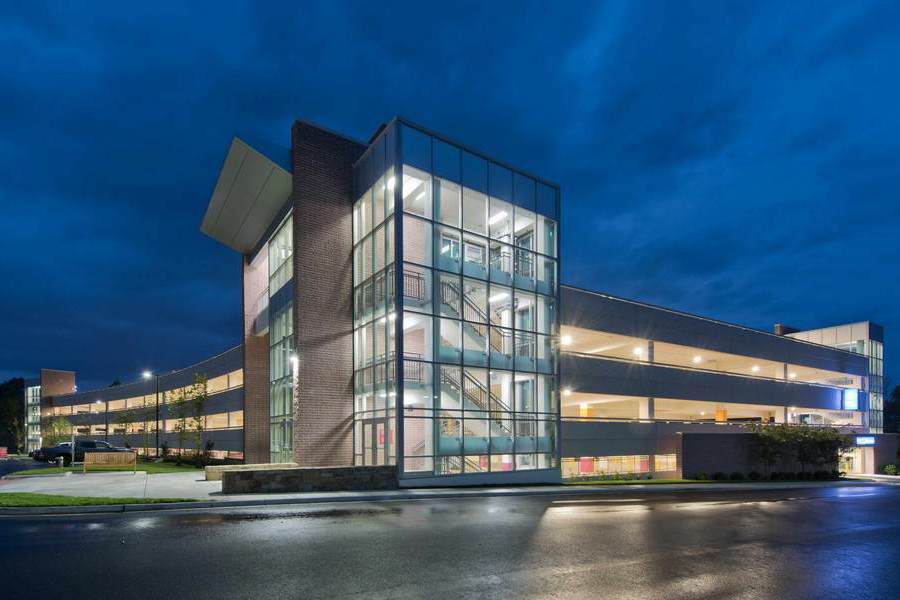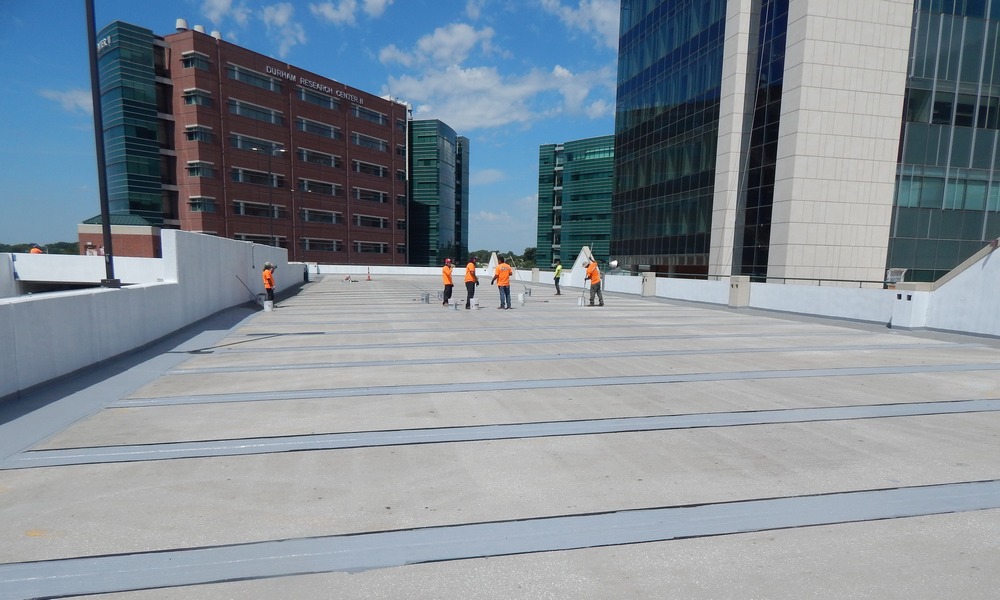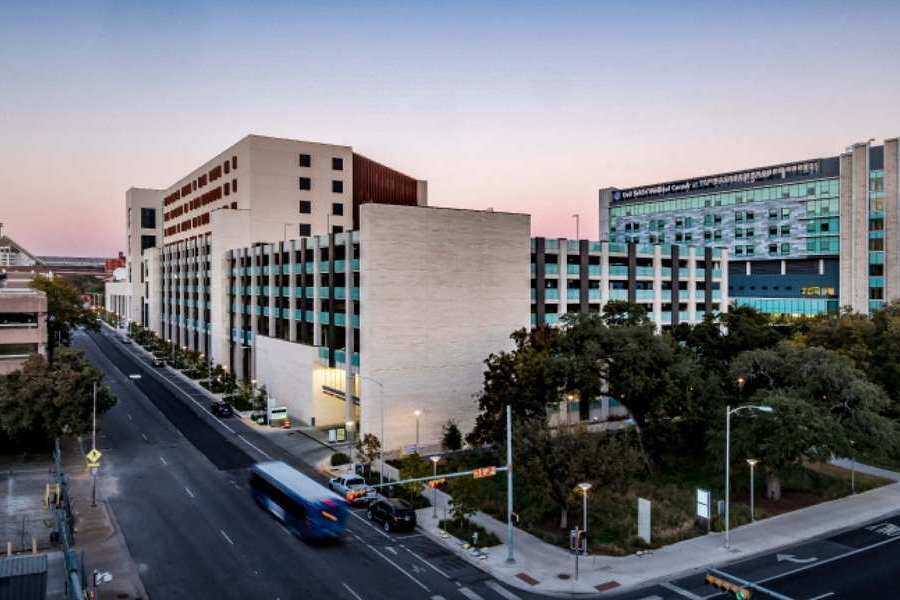 Inova Loudoun Hospital Parking Garage, Leesburg, Virginia.
Inova Loudoun Hospital Parking Garage, Leesburg, Virginia.  Nebraska Medical Center Durham Parking Structure, Omaha, Nebraska.
Nebraska Medical Center Durham Parking Structure, Omaha, Nebraska.  UT Austin Dell Medical School, Health Center Parking Garage, Austin, Texas.
UT Austin Dell Medical School, Health Center Parking Garage, Austin, Texas. Subscribe Now
Healthcare Projects Take Top Honors in International Parking Institute Annual Awards
Three healthcare projects recently won the International Parking Institute’s 2018 Awards of Excellence. The winners prove that when ever- expanding technology and creativity are applied to daunting architectural and parking challenges, the results can be extraordinary. Selected by a judging panel of architects, parking experts and city, airport and university officials, the winning parking facilities and programs include:
Category I: Best Design of a Parking Facility with Fewer than 800 Spaces
Inova Loudoun Hospital Parking Garage
Leesburg, Virginia, a suburb of Washington, D.C.
Owner: Inova Loudoun Hospital
Parking Consultant: Walker Consultants, Philadelphia, Pennsylvania
Completed Between: June 1, 2015-August 1, 2017
Cost: $14.9 million
Located in Leesburg, Virginia, Inova Loudon Hospital’s new parking garage for patients, visitors and staff looks like it has always been there, which is what the hospital was aiming for. The 765-stall structure was designed to be both easy to navigate and integrate with existing traffic patterns. Emergency room visitors park on the ground level, visitors to other areas are directed to higher tiers and staff are assigned spaces in a specific area. Clear sightlines to elevators and stairwells (open to the inside of the garage) provide easier wayfinding and greater security while a two-way vehicular ramp offers passive security and convenience. The cast-in-place structure was designed for minimal maintenance, with best-practice construction and design materials.
The garage’s exterior blends harmoniously into the campus. Vehicular portions are buff-colored, precast, concrete spandrel panels with a sandblasted finish; pedestrian areas are enclosed in highlighted masonry and glass. Wayfinding clearly identifies entrances, elevator and stair locations and outside directional information. Double-sided elevators and lobbies offer direct access from the parking areas to the lower-level entrance, as well as a future pedestrian bridge. Pedestrians enjoy dedicated waiting and walking areas that protect them from moving cars, and extensive glass walls offer natural light and views of the campus.
Photo courtesy of Eric Taylor © Taylor Design & Photography, Inc.
Category II: Best Design of a Parking Facility with 800 or More Spaces
UT Austin Dell Medical School, Health Center Parking Garage
Austin, Texas
Owner: University of Texas at Austin
Completed between: October 2014-August 2016
Cost: $23 million
The University of Texas at Austin’s new Dell Medical School aims to improve community-based healthcare, and the new, six-story, 1,120-stall garage serving its outpatient-care-based Health Transformation Building was designed to enhance that mission. With Waller Creek forming its eastern border and an oak-tree grove to the south, the site fell within 100- and 500-year flood plains; its structure shape and height were dictated by Capitol View Corridor restrictions that ensured visibility of Austin’s Capitol dome.
The garage’s cast-in-place concrete post-tensioning ensured durability and a space average of 376 square feet. Careful detailing and waterproofing of a split slab on the second level maximizes street frontage for retail and mercantile tenant spaces. The level one ambulatory surgery center faces Waller Creek and is serviced from the garage’s shared loading dock. Its critical care functions necessitated vibration and sound isolation from the garage superstructure. The ground-level café tucked into the northeast corner provides food service to the Health Transformation Building, as well as the adjacent Health Discovery Building, with outdoor seating available in the plaza between the buildings with a view of Walter Creek.
Levels 2-6 house reading and conference rooms and a creek-view terrace. Integrated lobbies on each level feature large wayfinding elements, level-reminder business cards and other navigation aids. Non-transient staff and medical physicians’ access reserved parking areas on level 4. A speed ramp to the second level allows for direct patient drop off, with integrated bypass lane and turn-around for mistaken drivers. Level 2 has 55 motorcycle permit spaces and accommodates emergency ambulances equipped with CO2 sensors and idling fans. Street-level bike parking offers six shower and changing facilities. The larger project is LEED Gold certified and includes many sustainable features, such as a 22,000-square-foot greenroof and rainwater capture/recycling system, which feeds a 27,000 gallon cistern visible on two levels.
Category V: Best Parking Facility Rehabilitation or Restoration
Nebraska Medical Center Durham Parking Structure
Omaha, Nebraska
Owner: Nebraska Medicine
Parking Consultant: Walker Consultants, Tampa, Florida
Completed between: June 2015-October 2016
Cost: $1.8 million
The Durham Parking Structure, built in 1989, is a vital asset for patients and visitors of the Nebraska Medical Center in Omaha, Nebraska. After nearly three decades, corrosion and leaking were widespread, and severe deterioration of structural members jeopardized safety. The existing parking function also forced circulation patterns that created the perception of a full facility, yet more than 10 percent of the capacity was hidden from drivers and often left unused.
The significant loss of parking precluded demolition, so separate improvement packages were developed to phase improvements, including major structural repair packages, waterproofing, striping and wayfinding signage. The entire facility was painted to improve reflectivity and LED lighting was installed to enhance safety. Eight phases of closures during two years allowed work to go on 24/7. As the parking function had no significant structural modifications, Nebraska Medicine realized tremendous safety and parking improvements at minimum capital cost. The result is a much-improved parking experience for visitors that will serve the Omaha metro area for decades.
Challenges were mitigated during the project. Walker Consultants designed a new function that implemented separate up-and-down-bound circulation routes. 52 spaces were added by changing the angle of parking from 60 to 75 degrees. Revised circulation routes added 80 spaces, and some 65 accessible spaces were added in protected, convenient parking areas serving patients and visitors.
Tags: awards of excellence, Best Practices, Construction, International Parking Institute, Sustainability, Wayfinding
Posted June 15, 2018
More Articles:
- Coverings 2024
Apr 22, 2024 – Apr 25, 2024 - Hospital, Outpatient Facilities & Medical Office Buildings Summit
Apr 25, 2024 – Apr 25, 2024 - CxA Workshop & Exam
Apr 29, 2024 – Apr 30, 2024 - EMP Seminar & Exam at CxEnergy 2024
Apr 29, 2024 – Apr 30, 2024 - CxEnergy
Apr 29, 2024 – May 2, 2024 - PHCC West 2024
Apr 29, 2024 – May 2, 2024 - Lean in Design Forum 2024
May 1, 2024 – May 2, 2024










